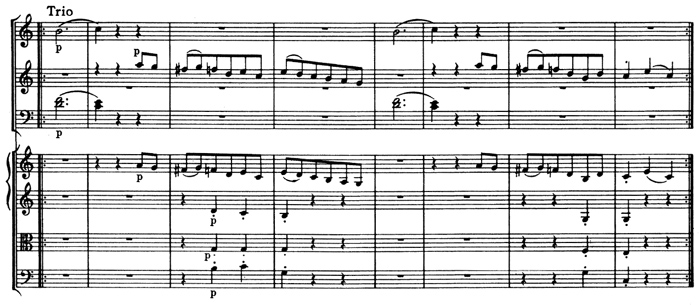Wolfgang Amadeus Mozart
Symphony No.41 in C major, K.551, “Jupiter”
Media Review / Comparison
2015-04-05 — Original posting
2016-08-04 — Brushed up for better readability
Table of Contents
Introduction / The Recordings
This posting is about the Symphony No.41 in C major, K.551, “Jupiter”, by Wolfgang Amadeus Mozart (1756 – 1791), of which I currently have two recordings:
- Christopher Hogwood / The Academy of Ancient Music (1983)
- Jaap ter Linden / Mozart Akademie Amsterdam (2002)
Both these recordings are recent acquisitions on CD. In my LP collection, I only had Karl Böhm‘s complete Mozart symphony recording. I’m not particularly eager to listen to that again…
Background, About the Composition
Wolfgang Amadeus Mozart (1756 – 1791) wrote his last symphony in 1788. The nickname “Jupiter” is not Mozart’s. It was created by the violinist, conductor and impresario Johann Peter Salomon (1745 – 1815) in an arrangement of that symphony for piano. I will save myself the words on an analysis: the symphony is very well-known and has been discussed extensively elsewhere. Just so much: the first three movements are not particularly elaborate in their structure. As a composer, Mozart appears to have put all of his power, effort and sophistication onto the last movement:
The Movements
The Symphony No.41 in C, K.551, “Jupiter” features the following four movements (the score samples show only selected voices):
I. Allegro vivace (4/4)
313 bars
This is a regular sonata movement, the exposition (120 bars) is repeated. It starts with the following theme (only string voices shown):
Sir Roger Norrington describes this as a “Royal theme, alternating between war (e.g., bars 1 and 5) and love (e.g., bars 3 and 4)” — the interpretations of this movement that I know (the two below, Norrington’s from a concert, as well as traditional interpretations that I remember from earlier times) are all pretty coherent in this movement — at least, as far as the tempo is concerned.
II. Andante cantabile (3/4)
101 bars
The first part (44 bars) in this movement is repeated; the violins play con sordino (with mutes) throughout; in the string section, the movement starts with the following theme:
Quite often, this movement is played too slow: it’s an Andante in 3/4, after all! Under this aspect, the movement (with its muted violin voices) should not be “celebrated”. When played faster, it is more than just sad, but a movement exhibiting tragic aspects. Did Mozart feel that his life span would be shorter than he must have hoped?
III. Menuetto (Allegretto) & Trio (3/4)
59 + 28 bars
Here, both the Menuetto (16 + 43 bars) and the Trio (8 + 20 bars), have both parts repeated, the Menuetto is played da capo and starts with the following bars:
and the short Trio begins with
Interestingly, Mozart added no dynamic annotations other than f and p throughout this movement.
IV. Finale: Molto allegro (2/2, alla breve)
423 bars
This is again a sonata movement; the exposition (157 bars) is repeated; it starts withThis is much more than “just” a sonata movement. Besides the first theme shown above, four additional melodic themes are introduced. The movement features its many five-part fugato sections, some combining all five melodic themes. Also the development and recapitulation part (199 bars) has repeat signs, and there is an extra Coda of 67 bars. Some conductors may take the second repeat as “pure convention” (as in sonata movements, typically just the exposition is repeated). However, Mozart would barely have added explicit lead-back bars if this was the case.
As Sir Roger Norrington explained during a concert in Zurich, Mozart had studied Bach’s music, and this composition was meant to be the culmination of his symphonic oeuvre, so he put all of his contrapuntal art and knowledge into this last movement, and “in order to show how very clever he is” (Norrington’s words), he wanted to have the second part repeated as well. This argument may be an exaggeration — but it still makes sense to me. In addition, the movement is written in alla breve (2/2) notation, and the tempo annotation is Molto allegro — so, it is meant to be played faster than many (most?) people expect.
The Interpretations
Both recordings below are historically informed and both use period instruments:
Christopher Hogwood / The Academy of Ancient Music
Mozart: The Symphonies
Christopher Hogwood / The Academy of Ancient Music
Decca / L’oiseau-lyre 452 496-2 (19 CDs, stereo); ℗ 1979 – 1986 / © 1997
Booklet: 127 pp. e/f/d/i

For general information see the posting “Mozart: Symphony in D, K.19“. Recording date: 1983.
Notes on the Movements
I. Allegro vivace (4/4)
Duration: 11’01”; 1/4 = 160
A little faster than Jaap ter Linden. The string tone is somewhat rough, “sharp”, and may feel somewhat tiring after a while (some or most of this may be caused by the sound engineer & the acoustics, rather than the players).
II. Andante cantabile (3/4)
Duration: 9’14”; 1/4 = 46
Too slow for an Andante in 3/4. This almost feels like an Andante played on quavers, hence it still feels (too?) “busy”. I also question the tempo stability in this recording. Instabilities may be the result of combining takes from different sessions. Here, it also becomes obvious that Hogwood is directing from the fortepiano, as he is occasionally a tad ahead of the orchestra. Whether the use of a fortepiano in this late symphony is still appropriate may be debatable. Even though they must be playing with mutes, the violins retain some (too much?) of their sharpness in sound.
III. Menuetto (Allegretto) & Trio (3/4)
Duration: 5’54”; 1/4 = 150
The first part in the da Capo section is repeated as well. A good recording in general, maybe with a slight tendency towards belly notes (<>), and probably too uniform, overall.
IV. Finale: Molto allegro (2/2, alla breve)
Duration: 11’50”; 1/2 = 138
Hogwood repeats both the exposition, as well as the development and recapitulation parts. The articulation in the short notes is often somewhat superficial. The tempo could be faster (and more dramatic) for a Molto allegro in alla breve notation. It sound like tempo-wise Hogwood is following the conventional interpretations. Even though the articulation is light in general, the movement starts to suffer from lengths with both repeats at this tempo.
Overall Duration: 37’57”
Rating (see above for details): 4.0 (4 / 4 / 4 / 4) — A good, historically informed interpretation. Some deficiencies in the sound engineering, and, sadly, somewhat conventional in the tempo.
Jaap ter Linden / Mozart Akademie Amsterdam
Mozart: Complete Symphonies
Jaap ter Linden / Mozart Akademie Amsterdam
Brilliant classics 94295 (11 CDs, stereo); © 2011
Booklet: 23 pp. English

For general information see the posting “Mozart: Symphony in D, K.19“. Recording date: 2002.
Notes on the Movements
I. Allegro vivace (4/4)
Duration: 11’42”; 1/4 = 150
Round, full tone, slightly slower than Hogwood, more careful in articulation and tone, balanced in dynamics & sound. Jaap ter Linden avoids harshness in tone and articulation. String arpeggi appear softer, and not necessarily as sforzandi (unless specified in the score). A nice recording, even though it may sound slightly muffled, due to either the acoustics and/or the sound engineering.
II. Andante cantabile (3/4)
Duration: 10’15”; 1/4 = 44
Too slow for an Andante: better in sound than Hogwood’s recording, but even slower, though without tempo instabilities, and not so much played on the quavers, so doesn’t feel quite that “busy”. In this interpretation, the movement may sound somewhat melancholic. To me, it lacks the tragic (if not dramatic) aspects in Sir Roger Norrington’s interpretation.
III. Menuetto (Allegretto) & Trio (3/4)
Duration: 4’25”; 1/4 = 166 / 160
No repeats in the da Capo section, and a slightly fresher tempo than with Hogwood, more differentiated in dynamics. An interesting idea: the marked caesura after the Trio. To me, an excellent interpretation!
IV. Finale: Molto allegro (2/2, alla breve)
Duration: 9’03”; 1/2 = 132
Jaap ter Linden ignores the repeat signs around the second part: a mistake, as Sir Roger Norrington probably would claim. This interpretation is even slightly slower than Hogwood’s. But it has vastly more differentiation (with some superficialities in the fast notes, though), and without the second repeat, it is less prone to suffering from lengths. Overall, the interpretation would have profited from a faster tempo, more drama & turmoil.
Overall Duration: 35’23”
Rating (see above for details): 4.5 (5 / 4 / 5 / 4) — Among the two interpretations discussed here, I have a slight preference for this one (also in the last movement). However, I miss the fire and the drama in Sir Roger Norrington’s interpretation!
Addendum
Mozart’s Symphony in C major, K.551 featured in a concert at the Tonhalle in Zurich, on 2015-03-28, with Sir Roger Norrington and the Zurich Chamber Orchestra. See my concert review for Bachtrack.com. As this is in German, I have written up a separate, more extended review in the posting “Norrington & Arabella Steinbacher in Zurich, 2015-03-28“.











